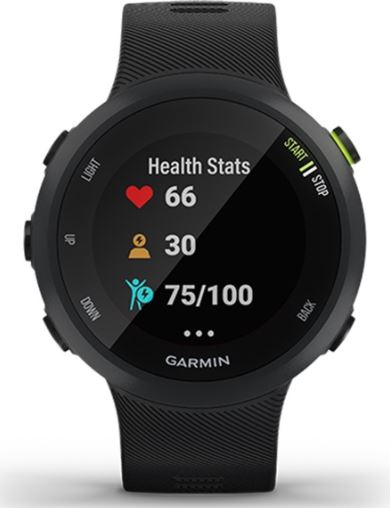Hey there. Welcome to our Garmin Forerunner 35 vs 45 comparison.
We tested these two running watches against each other indoors, outdoors, cycling, on the treadmill, and even on cheat days walking to the door to get our well-deserved pizza (meat lovers...hmmm…).

The Garmin 35 is made for entry-level runners. The 45 is for serious fitness enthusiasts.
In this review, we’ll cover:
- Who each model is for
- What’s new in the 45
- Whether the 45 is worth the extra money
- Specs like accuracy, design, display, and more
This article will give you all the key information you need to make an informed decision.
Let’s get to it:
Forerunner 35 vs. Forerunner 45: Is the 45 Worth the Extra Money?
The Forerunner 45 is the souped-up version of the 35.
For just a few dollars more, you get a clearer display, better design, more sport profiles, and a bunch of cool features and metrics that give you more variety, control, and insight for your workouts.
This is the best way to summarize the difference:
The Garmin 35 is made for entry-level runners. The 45 is for serious fitness enthusiasts.
If you’re working out with a Garmin Forerunner 45 on your wrist, you’ll:
- Gain deeper insight from more advanced metrics
- Have access to more diverse sport profiles so you can push harder. For example, elliptical, cardio, stairs, and even yoga
- Get hands on training from Garmin Coach to help you achieve goals faster and track progress
- Benefit from a more colorful display
- Get a sleeker, more comfortable watch
- Gain access to helpful safety features
We noticed the difference as soon as we started running with the 45 on. You’ll notice it almost immediately.
Not saying the 35 is bad. For the price, it’s an incredible value. But all of the upgrades on the 45 make it a far better, more valuable exercise watch.
Get the Forerunner 45 if…
We highly recommend the 45 over the 35. If you’re serious about losing weight, gaining an edge in competitive athletics, or improving your health, all of the sport profiles, metrics, and coaching will give you everything you need and more. You won’t get that with the 35. In fact, you might not get any value out of it at all aside from running.
Check here the complete specifications of Forerunner 45.
Get the Forerunner 35 if…
There are only two reasons to get the 35:
- If you’re on a serious budget: If you can’t spare the extra money, then stick to the 35. You’ll save $50 or so.
- You’re a complete beginner: If you’re a complete beginner, the 45 might be overkill. The 35 has everything you need plus nothing you don’t. Make sense? The 35 is designed as an entry-level watch for novices and there’s nothing wrong with that. Why spend the money if you won’t get the value?
Here’s why:
Key Upgrades in the Forerunner 45
Like we said before, the 45 is pretty much a big step up in every major way from the 35. You pay for those upgrades, but they’re worth it in our opinion. Here are the key changes in this model:
A Round, Lightweight Design

Goodbye square display.
Hello, 21st-century design.
Personally, we didn’t like the “1984 Apple Macintosh Home Computer” design of the 35. It felt like wearing a wrist computer more than a sports watch.
The 45 solves that. Plus it’s “transflective”, meaning it’s easily readable in direct sunlight. That way, you can quickly view the time and metrics even during mid-day without going blind.
And now the design is far more sleek. Here are the differences in dimensions (the 45 comes in 2 sizes):
- Large: 42 x 42 x 11.4mm (wrist size: 129-197m)
- Small: 39.5 x 39.5 x 11.4mm (wrist size 124-185mm)
The 35 is a standard 35.5 x 40.7 x13.4mm (wrist size: 140 - 200mm).
The added flexibility and improved design makes it pretty easy to wear 24/7, though not ideal.
More Sport Profiles

Garmin added heaps of sport/activity profiles to this bad boy. It really helps give you more variety. With the 35, you’re limited to just a few basic profiles like running or cycling.
The 45 has 12 activity profiles. Including:
- Running
- Treadmill
- Indoor track
- Bike
- Walk
- Yoga
- Cardio and elliptical training
- Stair stepping
Some of these are only accessible through Garmin Connect, but it’s a huge help to have them if you’re serious about fitness.
Note: The 45 can store up to 200 hours of workout data. The 35 doesn’t even come close (though you can upload data into the app and store it with no problems).
Garmin Coach Personal Training

This is our favorite upgrade.
Garmin Coach is a built-in personal trainer with pre-made fitness plans ranging from complete beginner up to 7-minute mile (a fairly advanced goal).
Since we’re a bit more advanced, we didn’t get the full value from it. But there’s a ton of value for beginners and intermediate runners. It definitely helps motivate you to stick to your goals.
Plus it adapts to your performance. Doing well? The app pushes harder. Struggling to hit your mark? Garmin Coach adjusts to help you hit the goal and motivate you to try harder the next time.
Cool Safety Features

This is going to sound super salesy, but it’s true.
The Garmin 45 could save your life in an emergency. They are:
- Incident detection: Garmin warns an emergency contact about strange incidents during activities such as a sudden drop in heartbeat.
- Assistance: Allows you to request assistance directly through the watch. Say, god forbid, some creep starts following you in a car, you can directly contact an emergency contact via the watch.
Garmin’s newly added key safety features are ideal for anyone who runs in the middle of nowhere, cycles on busy streets, or takes long hikes in the mountains. They’re especially valuable for women runners worried about being followed. One BBC study reported that over 40% of female runners have been followed while running. The extra money might be worth the price alone to some people.
Better, More Colorful Screen

Neither model is as clear as an Apple Watch, but the 45 is 60% sharper (208 x 208 for the 45 and 128 x 128 for the 35).
Plus it comes in vibrant colors. The 35 is only black and white.
New Activity Tracking

Garmin has once again added more metrics to the 45 that give you even deeper insight into your fitness levels.
If you’re still a beginner, then they won’t make much of a difference to you. But if you’re trying to squeeze every ounce of juice out of your workout, they’ll definitely give you that extra oomph you’ll need to feel healthier and get fitter.
The new metrics are:
- Fitness Age: An estimation of how old your body is (age is just a number, right?).
- Body Battery: An overall estimation of your energy level scale 1-100. Not sure how accurate this is, but it’s definitely cool to have as a barometer.
- All-Day Stress Levels: A measure of your body’s stress levels based on a 3-minute test performed while standing still.
You might also want to check the support videos for Forerunner 35.
Garmin Forerunner 45 Overview
The Forerunner 45 is the upgraded version of the 45 that reflects feedback given from high-level athletes about the 35.
Garmin added in pretty much everything the 35 was lacking, along with upgrading the screen and changing the design.
It’s one of the only legit sports watches for athletes that’s also reasonably priced. Along with running and cycling profiles, basic exercise metrics, and Garmin Connect, you also get personal coaching, extra profiles, safety features, and advanced metrics like stress and energy levels. Serious athletes will love the level of insight and control you get when exercising/wearing the 45.
Pros
- Sharper display
- Added safety features
- Garmin Coach
- More in-depth metrics
- 12 sport profiles, including popular gym activities
Cons
- Color display drains the battery faster
- Price
Garmin Forerunner 35 Overview
The Forerunner 35 is the next step in low-cost running watches. When it first came out, it was a huge upgrade over the 25. To this day it remains one of the most popular budget models.
The reason it’s so popular is that it gives you all the basics plus a few key upgrades to take your game to the next level, and it does it all for less than $100. It has a few cool smartwatch features, tracks your heartbeat, calories, time, and distance, plus it’s waterproof and helps track your heart rate. Perfect for runners on a budget if you ask us.
The biggest limitation is that it’s basically an entry-level running watch - nothing more and nothing less. It doesn’t give you the level of flexibility or control of the 45.
Pros
- Great for beginners
- Battery lasts all day
- Very reasonably priced
- Everything you need for running or cycling
Cons
- Limited features
- No advanced metrics
- Limited sport profiles
A Quick Side-By-Side Comparison
We want to share our experience exercising with both of these watches to give you a feel for how it’ll help you achieve your fitness goals.
Usability

Both watches are very easy to use, but the 45 is the clear winner here.
First, it has 5 buttons instead of 4, giving you faster access to features. And the sharper transflective display makes it super easy to view key metrics at a glance when running.
As you can see the image, it’s extremely user friendly (though admittedly it is still a bit basic).
Up, down, back, start/stop, light - it’s pretty simple and the display is super clear.
Comfort
Both are super comfortable, and we didn’t notice much of a difference between the two.
However, just the fact that the 45 fits a wider range of wrists give the edge here. The 45 fits anyone with a wrist 124 - 197mm. The circular design didn’t make much of a difference in the comfort, though.
Exercise Quality
The wider range of profiles, more metrics, and workout programs made the 45 a much better workout companion than the 35.
Also, the 45 has access to a wider range of satellites, making the tracking and GPS way more accurate. One huge advantage is the greater workout memory. It’s nice to have 200 hours of stored data so you don’t have to keep transferring data to the app.
Now you can get a clear overview of performance and progress without switching back and forth.
Guide: Garmin Forerunner Watches
Complete list:
